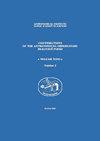用小型望远镜研究食双星
IF 0.2
4区 物理与天体物理
Q4 ASTRONOMY & ASTROPHYSICS
Contributions of the Astronomical Observatory Skalnate Pleso
Pub Date : 2020-04-01
DOI:10.31577/caosp.2020.50.2.395
引用次数: 0
摘要
明亮的变星在CCD相机时代被忽略了。此外,除了像BRITE和SMEI这样的专业项目外,在大多数调查中,明亮的恒星是无法测量的。在这张海报中,我们提出了一种廉价的方法来观测明亮的变星,学生、小型天文台和业余天文学家都可以使用。我们也给出了一些结果。本文章由计算机程序翻译,如有差异,请以英文原文为准。
Eclipsing binary research with mini telescopes
Bright variable stars became neglected in the epoch of CCD cameras. In addition, in most surveys bright stars are not measurable, apart from specialized projects like BRITE and SMEI. In this poster we present an inexpensive solution to observing bright variable stars accessible to students, small observatories and amateur astronomers. We also present some results.
求助全文
通过发布文献求助,成功后即可免费获取论文全文。
去求助
来源期刊
CiteScore
1.10
自引率
20.00%
发文量
4
审稿时长
>12 weeks
期刊介绍:
Contributions of the Astronomical Observatory Skalnate Pleso" (CAOSP) is published by the Astronomical Institute of the Slovak Academy of Sciences (SAS). The journal publishes new results of astronomical and astrophysical research, preferentially covering the fields of Interplanetary Matter, Stellar Astrophysics and Solar Physics. We publish regular papers, expert comments and review contributions.

 求助内容:
求助内容: 应助结果提醒方式:
应助结果提醒方式:


